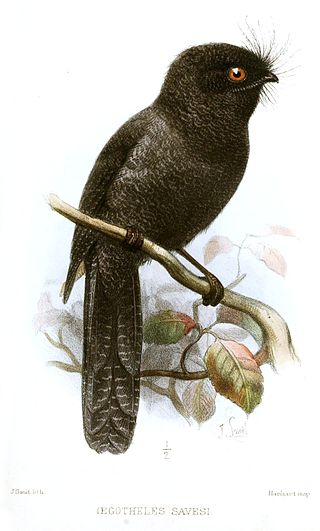
The Apodiformes is an order, or taxonomic grouping, of birds which traditionally contained three living families—the Apodidae (swifts), the Hemiprocnidae (treeswifts), and the Trochilidae (hummingbirds); however, in the Sibley-Ahlquist taxonomy, this order is elevated to the superorder Apodimorphae, in which hummingbirds are separated into a new order, the Trochiliformes. With nearly 450 species identified to date, it is the most diverse order of birds after the Passeriformes.

Owlet-nightjars are small crepuscular birds related to the nightjars and frogmouths. Most are native to New Guinea, but some species extend to Australia, the Moluccas, and New Caledonia. A flightless species from New Zealand is extinct. There is a single monotypic family Aegothelidae with the genus Aegotheles.

The red-necked nightjar is the largest of the nightjars occurring in Europe. It breeds in Iberia and North Africa, and winters in tropical West Africa.

Jerdon's nightjar is a medium-sized nightjar species native to southern India and Sri Lanka. Formerly considered as a subspecies of the long-tailed nightjar, it is best recognized by its distinctive call which sounds like a wooden plank being beaten periodically with each note ending in a quaver. The common name commemorates Thomas C. Jerdon who described the species.

The Australian owlet-nightjar is a nocturnal bird found in open woodland across Australia and in southern New Guinea. It is colloquially known as the moth owl. It is the most common nocturnal bird in Australia, and despite suffering from predation and competition by introduced species it is not considered threatened.

The New Caledonian owlet-nightjar, also known as the enigmatic owlet-nightjar, is a large owlet-nightjar with vermiculated grey-brown and black plumage. It has a long, slightly rounded tail, short, rounded wings, and long, stout legs. Its voice is unknown, but other owlet-nightjar species make churring and whistling sounds. It is the second-largest known owlet-nightjar, much larger than the Australian owlet-nightjar.

The New Zealand owlet-nightjar is an extinct, comparatively large species of owlet-nightjar formerly endemic to the islands of New Zealand. Fossil remains indicate the species was once widespread across both the North Island and the South Island.

Sick's swift is a species of swift in the family Apodidae. It was previously considered conspecific with the smaller ashy-tailed swift, but a study published in 1997 found that Sick's swift was closer to the chimney swift. The English name commemorates the German-born ornithologist Helmut Sick who studied South American birds. It is a migratory species that breeds in central South America and overwinters in northern South America. The IUCN has listed it as being of "Least Concern".

The African barred owlet is a species of small owl in the family Strigidae found in much of southern, central and eastern Africa. The taxon may be four species rather than a single species.

The mountain owlet-nightjar is a species of bird in the family Aegothelidae. It is found in the highlands of New Guinea. Its natural habitat is subtropical or tropical moist montane forests.

The barred owlet-nightjar is a species of bird in the owlet-nightjar family Aegothelidae. It is found in New Guinea. The species was originally thought to be the same species as the Australian owlet-nightjar, until that species was found within the range of the barred owlet-nightjar. It was also considered to be the same species as the Vogelkop owlet-nightjar. There are three subspecies, the nominate, from south-eastern New Guinea, A. b. wiedenfeldi from northern New Guinea, and A. b. plumifer from the D’Entrecasteaux Islands.

The Moluccan owlet-nightjar, also known as the long-whiskered owlet-nightjar, is a species of bird in the family Aegothelidae. It is endemic to the northern Moluccas.

The feline owlet-nightjar is a species of bird in the family Aegothelidae. It is found in New Guinea. Its natural habitat is subtropical or tropical moist montane forests.
The starry owlet-nightjar, also known as the spangled owlet-nightjar, is a species of bird in the family Aegothelidae. It is endemic to Papua New Guinea. Its natural habitat is subtropical or tropical moist lowland forests. It is threatened by habitat loss.

Wallace's owlet-nightjar is a species of bird in the family Aegothelidae. It is found in New Guinea.
Paleontology or palaeontology is the study of prehistoric life forms on Earth through the examination of plant and animal fossils. This includes the study of body fossils, tracks (ichnites), burrows, cast-off parts, fossilised feces (coprolites), palynomorphs and chemical residues. Because humans have encountered fossils for millennia, paleontology has a long history both before and after becoming formalized as a science. This article records significant discoveries and events related to paleontology that occurred or were published in the year 1968.

The Vogelkop owlet-nightjar or allied owlet-nightjar is a species of bird in the family Aegothelidae. It can be found in New Guinea. It is known from Bird's Head Peninsula and Eastern Highlands Province.

Strisores, sometimes called nightbirds, is a clade of birds that includes the living families and orders Caprimulgidae, Nyctibiidae (potoos), Steatornithidae (oilbirds), Podargidae (frogmouths), Apodiformes, as well as the Aegotheliformes (owlet-nightjars) whose distinctness was only recently realized. The Apodiformes and the Aegotheliformes form the Daedalornithes.

The grey-rumped swiftlet or grey-rumped swiftlet, is a small bird in the swift family Apodidae. It is endemic to some islands in the Philippines.















